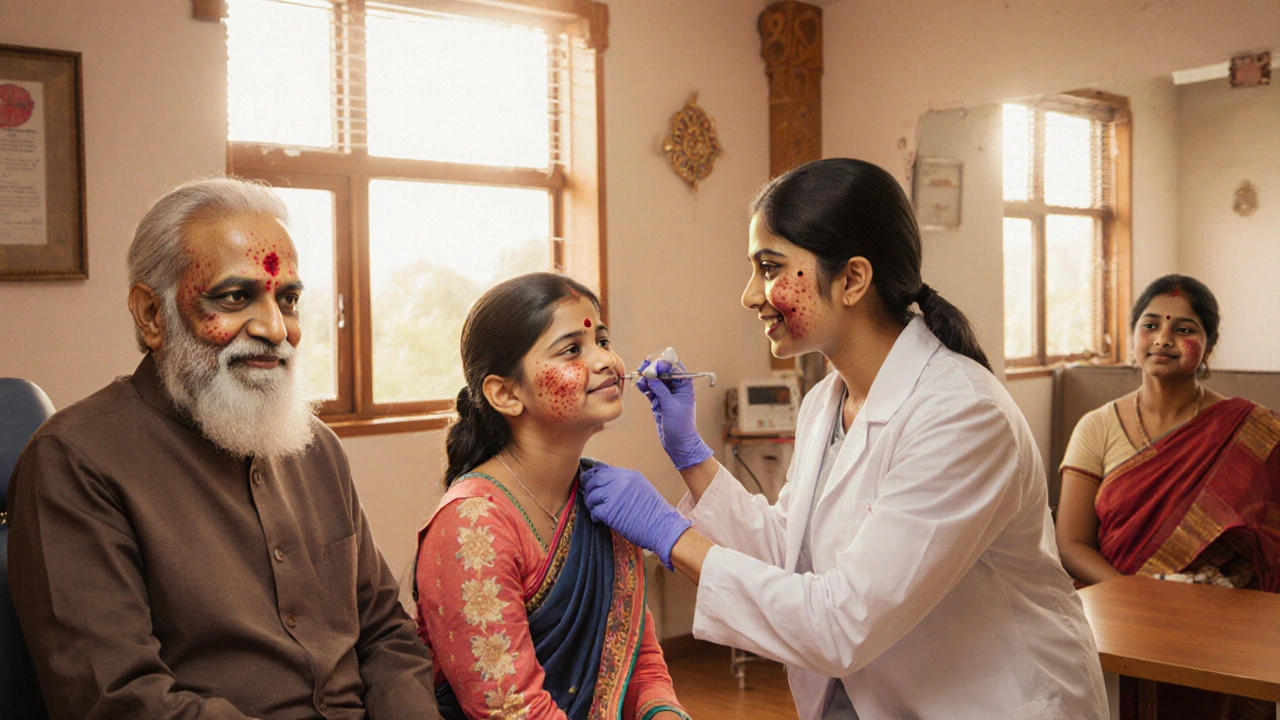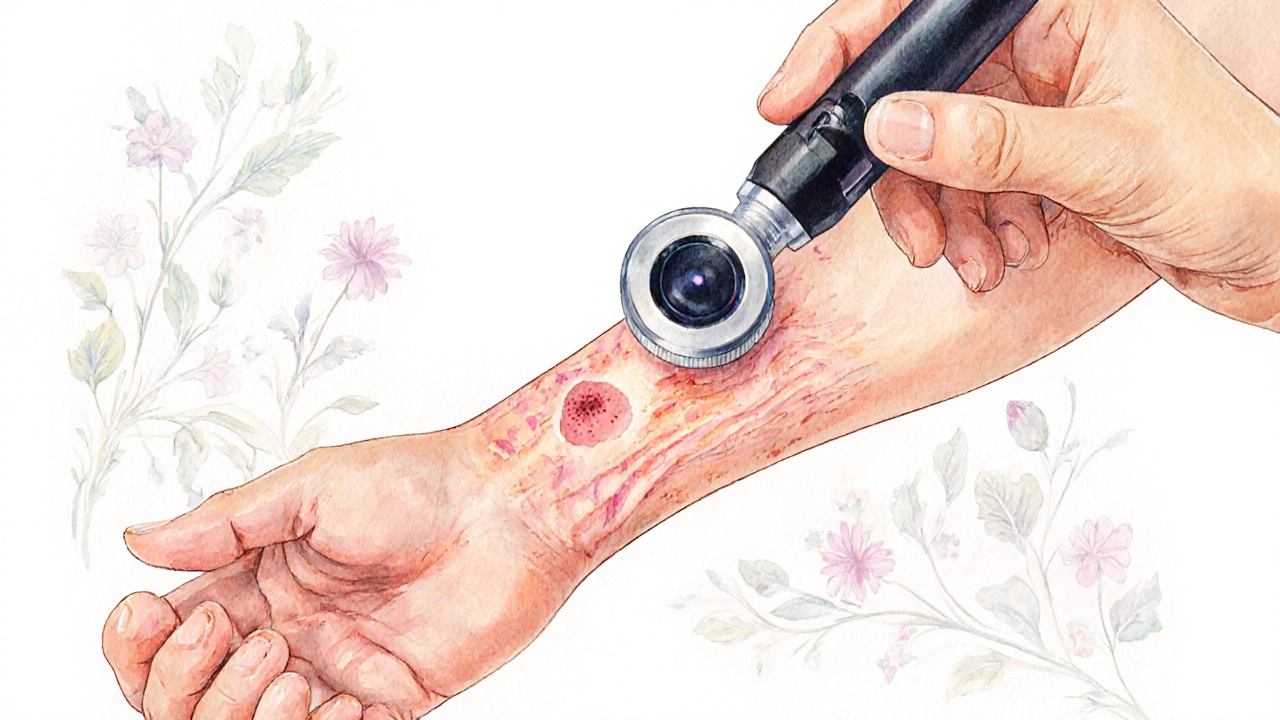
Skin Health Knowledge Quiz
This interactive quiz tests your understanding of common skin conditions and their treatments. Test yourself to see how much you know about dermatology!
1. Which of the following is NOT a common skin condition treated by dermatologists?
2. What is the primary treatment for severe acne?
3. What is the most common type of skin cancer?
4. Which procedure is commonly used for removing suspicious skin lesions?
5. What is the main goal of cosmetic dermatology?
Dermatology is a medical specialty focused on the skin, its diseases, and cosmetic health. If you’ve ever wondered what a dermatologist actually does, the answer lies in the sheer variety of ailments they handle. From pesky pimples to life‑threatening melanoma, the field covers everything that lives on or under the surface of our bodies. This guide walks you through the most common conditions, how they’re diagnosed, and the treatments you can expect.
Key Takeaways
- Dermatology treats both medical and cosmetic skin issues.
- Common conditions include acne, eczema, psoriasis, rosacea, and skin cancers such as melanoma.
- Diagnosis often involves visual exams, dermoscopy, and skin biopsies.
- Treatments range from topical creams to laser surgery and systemic medications.
- Early detection of skin cancer dramatically improves outcomes.
Medical Dermatology: Core Skin Conditions
Acne is a common inflammatory condition of the pilosebaceous unit that produces pimples, blackheads, and cysts. It affects up to 85% of teenagers and many adults. Treatment typically starts with topical retinoids, benzoyl peroxide, or oral antibiotics, moving to isotretinoin for severe cases.
Eczema (atopic dermatitis) is a chronic, itchy skin inflammation driven by genetic and environmental factors. Management relies on emollients, topical corticosteroids, and newer biologics like dupilumab for moderate‑to‑severe disease.
Psoriasis is a autoimmune disorder that speeds up skin cell turnover, causing red, scaly plaques. First‑line therapy includes topical vitamin D analogues; systemic options range from methotrexate to biologic agents targeting IL‑17 or IL‑23.
Rosacea is a vascular condition characterized by facial redness, papules, and visible blood vessels. Lifestyle triggers (spicy food, alcohol) are addressed, while topical metronidazole or oral doxycycline reduce inflammation.
Seborrheic Dermatitis is a sebaceous‑gland‑related rash that appears as flaky, greasy patches on the scalp, eyebrows, and torso. Antifungal shampoos (ketoconazole) and low‑potency steroids are standard care.
Dermatological Surgery & Skin Cancer
When skin cells turn malignant, dermatologists become surgeons. The two most prevalent skin cancers are Basal Cell Carcinoma (BCC) and Melanoma. BCC grows slowly and rarely spreads, while melanoma is aggressive and can metastasize.
Diagnosis often starts with a visual exam using dermoscopy, a handheld microscope that reveals pigment patterns. Suspicious lesions are excised and sent for histopathology.
Treatment options include:
- Surgical excision - the gold standard for most cancers.
- Cryotherapy - freezing superficial lesions.
- Mohs micrographic surgery - layer‑by‑layer removal for high‑risk areas.
- Topical agents (imiquimod, 5‑fluorouracil) for superficial BCC.
- Targeted therapy (BRAF inhibitors) and immunotherapy (checkpoint inhibitors) for advanced melanoma.

Cosmetic Dermatology: Enhancing Skin Appearance
Cosmetic dermatology is a sub‑specialty focusing on aesthetic improvement, such as wrinkle reduction, pigment correction, and scar remodeling. While not life‑saving, these procedures boost confidence and are often covered by skin‑care insurance when medically indicated.
Popular interventions include:
- Botox injections - temporarily relax facial muscles to soften lines.
- Dermal fillers - restore lost volume using hyaluronic acid or calcium hydroxylapatite.
- Laser resurfacing - targets texture, pigmentation, and fine lines.
- Chemical peels - exfoliate the outer skin layers for smoother tone.
- Microneedling - stimulates collagen production for scar reduction.
Comparison: Medical vs Cosmetic Dermatology
| Aspect | Medical Dermatology | Cosmetic Dermatology |
|---|---|---|
| Primary Focus | Treatment of disease | Improvement of appearance |
| Common Conditions | Acne, eczema, psoriasis, skin cancer | Wrinkles, hyperpigmentation, scars |
| Typical Procedures | Biopsy, excision, phototherapy | Botox, fillers, laser resurfacing |
| Insurance Coverage | Usually covered | Rarely covered (cosmetic only) |
| Goal | Restore health | Enhance aesthetics |
Related Fields and Emerging Trends
Dermatology overlaps with several other specialties. Immunodermatology studies immune‑mediated skin diseases, bridging dermatology and rheumatology. Dermato‑oncology focuses on skin cancer prevention and treatment, often collaborating with oncology.
Tele‑dermatology has surged since 2020, allowing patients to send high‑resolution photos for preliminary assessment. Artificial intelligence tools now assist in pattern recognition of malignant lesions, improving early detection rates by up to 20% in pilot studies.
Next Steps for Readers
- If you notice a new mole or persistent rash, schedule an appointment with a board‑certified dermatologist.
- Maintain a skin‑care routine: gentle cleanser, daily sunscreen (SPF30+), and moisturiser.
- Consider a skin‑type analysis to tailor products and preventive measures.
- Stay informed about emerging treatments such as biologics for psoriasis or AI‑driven mole checks.

Frequently Asked Questions
What skin conditions can a dermatologist treat?
Dermatologists manage everything from acne, eczema, and psoriasis to rosacea, seborrheic dermatitis, and allergic rashes. They also diagnose and treat skin cancers like basal cell carcinoma, squamous cell carcinoma, and melanoma.
How is skin cancer diagnosed?
Diagnosis typically starts with a visual exam and dermoscopy. Suspicious lesions are biopsied, and the sample is examined under a microscope to confirm the type and stage of cancer.
When should I see a dermatologist for acne?
If over‑the‑counter products haven’t helped after 6-8 weeks, or if you have cystic lesions, nodules, or scarring, it’s time to consult a dermatologist for prescription‑strength topical or oral therapies.
What is the difference between medical and cosmetic dermatology?
Medical dermatology focuses on diagnosing and treating skin diseases, while cosmetic dermatology aims to improve appearance through procedures like Botox, fillers, and laser resurfacing. Both are practiced by dermatologists, but the goals differ.
Can I use tele‑dermatology for a skin check?
Yes. Many clinics now offer virtual appointments where you upload clear photos of the affected area. A dermatologist can provide a preliminary assessment and recommend in‑person follow‑up if needed.
What treatments are available for psoriasis?
Topical steroids, vitamin D analogues, and phototherapy are first‑line. Moderate‑to‑severe cases often require systemic agents like methotrexate, cyclosporine, or biologics that target specific immune pathways (IL‑17, IL‑23).
How often should I get a skin‑cancer screening?
People at average risk should have an annual full‑body skin exam. Those with a family history, fair skin, or many moles may need more frequent checks, sometimes every 6 months.
 Hair Care
Hair Care